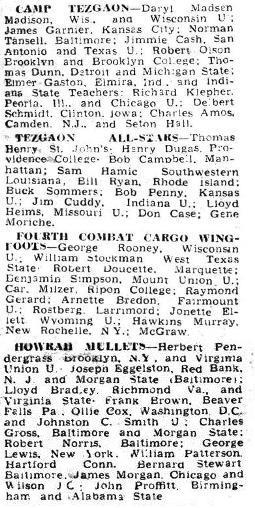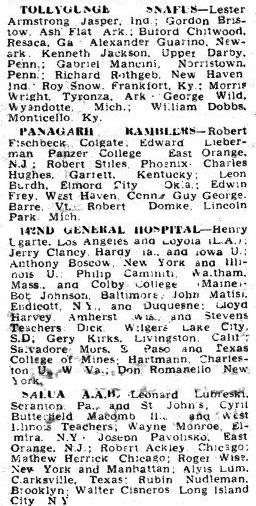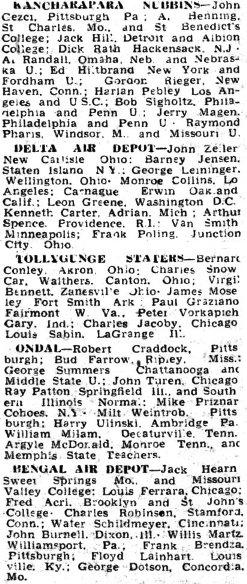|
10TH, 14TH AF'S BROKEN UP SHANGHAI - (ANS) - The 10th and 14th Air Forces went out of existence Monday. Lt. Gen. George Stratemeyer, commanding general of the Army Air Forces in China, announced that headquarters of both forces were put on a non-operational basis and were processing their men for return to the States. |
 Vol. IV No. 13 Reg. No. L5015 Delhi, Thursday, Dec. 6, 1945
Vol. IV No. 13 Reg. No. L5015 Delhi, Thursday, Dec. 6, 1945
|
HEY, SHE'S CINDERELLA! 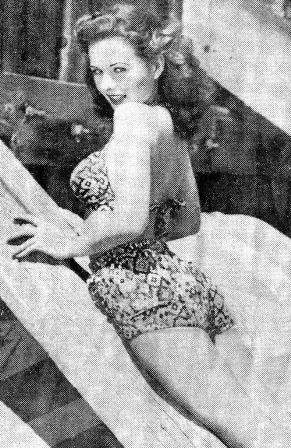
|
The United Press reported that Hurley resigned because "career diplomats" were reportedly undermining his efforts to unify opposing factions in China. According to the United Press, the probe is expected to grow out of his charge, which has stirred up hot pro and con discussions in the Stateside press.
Meanwhile, in Chungking, Lt. Gen. Albert C. Wedemeyer, U.S. commander in China, was reported by Army News Service as telling newsmen that he believed Marshall is being sent to China "to make a survey of the situation and make appropriate recommendations to President Truman concerning future United States assistance or military aid to China."
MAY TESTIFY
It appeared that before Marshall leaves for China, however, he will be called to testify before the joint Congressional committee investigating the Pearl Harbor disaster.
Marshall, who went into retirement only a week ago, will act as Hurley's successor only temporarily, the news services reported, and will be known as a special envoy instead of ambassador.
The selection of Marshall was hailed throughout the country. The observation was made that as chief of staff of the U.S. Army, he was in a position to be well informed on the situation in the Far East, including the position of the British, Dutch and French. There was some conjecture, according to press reports, that he might even visit Indonesia.
FEAR WAR
Army News Service noted that Marshall is going to China at a time when there is growing concern in the United States over the possibility of Civil War in China as a result of a dispute between the Central and Communist forces.
By selecting a five-star general to succeed one with two stars, rather than choosing a civilian diplomat, Army News Service said President Truman appeared to be emphasizing again the viewpoint that the present top job in China id the disarming of Japanese troops. Both War and State Departments have reported repeatedly in recent weeks that U.S. troops are in North China only to facilitate the surrender of Jap forces and not as instruments of American foreign policy.
Hurley's resignation, which was reported to have come as a full surprise to President Truman, was accompanied by the statement that American foreign policy had failed in Asia.
ANS quoted Hurley as saying in a 1,500-word, formal statement that the U.S. "finished the war in the Far East furnishing lend-lease supplies and using all our reputation to undermine democracy and bolster imperialism and communism."
He said President Roosevelt sent him to China to prevent the collapse of the Chiang Kai-shek government and to keep the Chinese Army in the war. However, he continued, "our professional diplomats continuously advised the Communists that my efforts in preventing collapse of the National Government did not represent the policy of the United States."
70,333 I-B; CHINA TROOPS HOME
Roundup Staff Article
More than 70,000 troops from the India-Burma and China Theaters have been returned to the United States, Navy Secretary James V. Forrestal reported Saturday in Washington according to Army News Service.
Forrestal listed returnees from the India-Burma and China Theaters as totaling 70,333 troops. At the same time he disclosed that 36 ships now being used to ship troops to the United States from the China and I-B Theaters have a total capacity of 96,356 personnel.
In his Washington statement, Secretary Forrestal disclosed that a transportation crisis is developing on the West Coast where the rate of troops returning is exceeding the capacity of the railroads.
Forrestal's statement listed a total of 3,469,415 Army and Navy personnel as having been returned to the United States from all overseas theaters. Largest theater represented was the ETO from whence 2,251,338 troops have been sent to the United States.
HISTORY PRINTED
A history of Merrill's Marauders, famous U.S. outfit that cleared the Japanese out of the North Burma jungles, will be available at the end of January. Anyone desiring a copy may procure one by writing to the Superintendent of Documents, Government Printing Office, Washington, D.C. The War Department has already mailed copies to every living member of the Marauders.
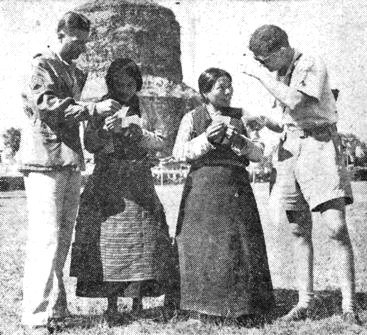 T/Sgt. Harry Flynn and S/Sgt. John Kapp of the 1311th ATC BU at Gaya are explaining photos bought from the two Tibetan
women at Sarnath. These women were part of a large group of Tibetan pilgrims.
T/Sgt. Harry Flynn and S/Sgt. John Kapp of the 1311th ATC BU at Gaya are explaining photos bought from the two Tibetan
women at Sarnath. These women were part of a large group of Tibetan pilgrims.
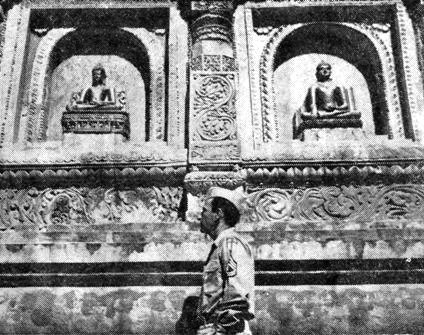 T/Sgt. Sidney Cohen of the 1311th ATC BU at Gaya, examines some of the Buddhist sculpture around the Bodh Gaya Temple,
built as a monument to the Lord Buddha because it was at this place that he first received his "enlightenment."
T/Sgt. Sidney Cohen of the 1311th ATC BU at Gaya, examines some of the Buddhist sculpture around the Bodh Gaya Temple,
built as a monument to the Lord Buddha because it was at this place that he first received his "enlightenment."
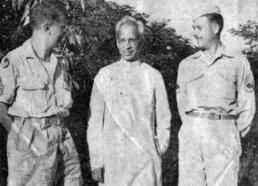
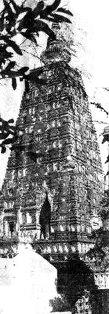
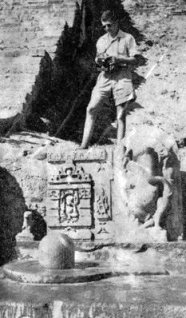 LEFT: Sir Sarvepalli Radhakrishnan, Vice-Chancellor of Benares Hindu University, poses with Sgts. Kapp and Flynn.
Sir Radhakrishnan, who teaches Eastern religions and ethics at Oxford University, plans to visit America.
CENTER: Temple of Bodh Gaya - erected on the spot where Lord Buddha received his enlightenment. Built many hundreds
of years ago, it is excellently preserved. Until quite recently when the area was excavated, almost the entire temple
was underground.
RIGHT: Sgt. Kapp prepares to photograph some of the many stone idols which adorn the banks of the Ganges at Benares.
The image on the left is Hanuman, God of Power; center is the emblem of Shiva (lingam and yoni), God of Life; on the
right is Ganesh, God of Wealth or Luck.
Pictures were furnished the Roundup by T/Sgt. Edward Wein of Public Relations.
LEFT: Sir Sarvepalli Radhakrishnan, Vice-Chancellor of Benares Hindu University, poses with Sgts. Kapp and Flynn.
Sir Radhakrishnan, who teaches Eastern religions and ethics at Oxford University, plans to visit America.
CENTER: Temple of Bodh Gaya - erected on the spot where Lord Buddha received his enlightenment. Built many hundreds
of years ago, it is excellently preserved. Until quite recently when the area was excavated, almost the entire temple
was underground.
RIGHT: Sgt. Kapp prepares to photograph some of the many stone idols which adorn the banks of the Ganges at Benares.
The image on the left is Hanuman, God of Power; center is the emblem of Shiva (lingam and yoni), God of Life; on the
right is Ganesh, God of Wealth or Luck.
Pictures were furnished the Roundup by T/Sgt. Edward Wein of Public Relations.
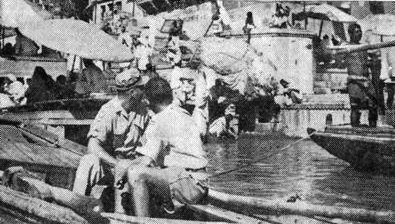 Sgts. Kapp and Flynn pause for a few moments to watch some of the Hindu bathers at one of the many bathing ghats in the
river Ganges at Benares. To bathe in the sacred waters of the Ganges in an attempt to wash away their worldly sins,
some devout Hindus travel hundreds of miles - sometimes on foot. It is a famous mecca for religious persons from the
whole of Asia.
Sgts. Kapp and Flynn pause for a few moments to watch some of the Hindu bathers at one of the many bathing ghats in the
river Ganges at Benares. To bathe in the sacred waters of the Ganges in an attempt to wash away their worldly sins,
some devout Hindus travel hundreds of miles - sometimes on foot. It is a famous mecca for religious persons from the
whole of Asia.
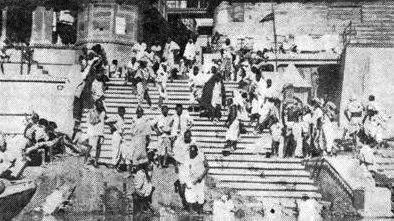 One of the many burning ghats on the banks of the Ganges at Benares. As the bodies are carried to the ghats, the
pallbearers chant "Ram nam satya haie," which means "God is a true God." Prior to placing the bodies upon the logs
for cremation, they are sprinkled with the holy river water. After the bodies are burnt, the ashes are strewn upon the
waters to be carried away by the tide.
One of the many burning ghats on the banks of the Ganges at Benares. As the bodies are carried to the ghats, the
pallbearers chant "Ram nam satya haie," which means "God is a true God." Prior to placing the bodies upon the logs
for cremation, they are sprinkled with the holy river water. After the bodies are burnt, the ashes are strewn upon the
waters to be carried away by the tide.
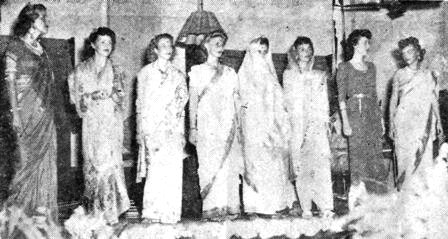 Standing before a packed house of G.I. co-workers are Air WAC's (left to right) Sgt. Dorjean Ellis, Sgt. Alice Marie
Mardian, Cpl. Betty King, Cpl. Elizabeth Stevens, Cpl. Adeline H. Hood, Cpl. Sara Love, S/Sgt. Cordellia Gerow, Cpl.
Virginia L. Paye. These WAC's participated in a modeling show of Indian saris (gown or dress) sponsored by the
American Red Cross in Calcutta.
Standing before a packed house of G.I. co-workers are Air WAC's (left to right) Sgt. Dorjean Ellis, Sgt. Alice Marie
Mardian, Cpl. Betty King, Cpl. Elizabeth Stevens, Cpl. Adeline H. Hood, Cpl. Sara Love, S/Sgt. Cordellia Gerow, Cpl.
Virginia L. Paye. These WAC's participated in a modeling show of Indian saris (gown or dress) sponsored by the
American Red Cross in Calcutta.
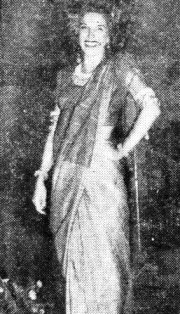 WAC Sgt. Dorajean Ellis of Phoenix, Ariz., goes a little out of uniform as she models what the best-dressed Indian
lady from Madras wears in saris, bare midriff et al.
WAC Sgt. Dorajean Ellis of Phoenix, Ariz., goes a little out of uniform as she models what the best-dressed Indian
lady from Madras wears in saris, bare midriff et al.
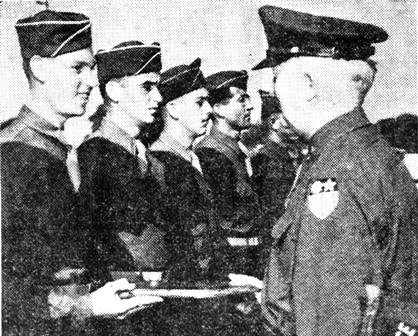 Maj. Gen. Thomas A. Terry, India-Burma Theater commander, is shown presenting the meritorious service unit plaque
to personnel of two Signal units recently. Left to right: T/4 Robert S. Bezark of Chicago and T/5 Thomas E. Cosgrove
of Des Moines, Ia., members of the 835th Signal Service Battalion; S/Sgt. Robert L. Stark of Rochester, N.Y., 1st
Sgt. Franklin D. Fielding of Provo, Utah, members of the 3371st Signal Photographic Service Co.
Maj. Gen. Thomas A. Terry, India-Burma Theater commander, is shown presenting the meritorious service unit plaque
to personnel of two Signal units recently. Left to right: T/4 Robert S. Bezark of Chicago and T/5 Thomas E. Cosgrove
of Des Moines, Ia., members of the 835th Signal Service Battalion; S/Sgt. Robert L. Stark of Rochester, N.Y., 1st
Sgt. Franklin D. Fielding of Provo, Utah, members of the 3371st Signal Photographic Service Co.
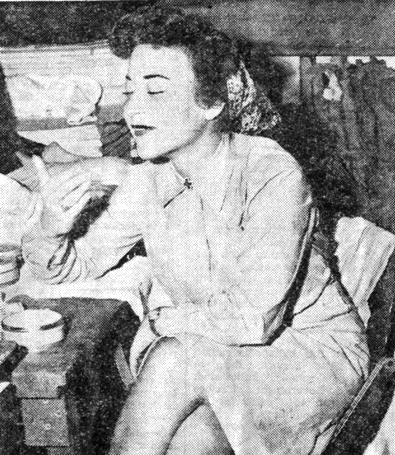 Miss Elinor Grant, ARC, who plays the aged Aunt Kate in the 40th Special Services production of "Personal Appearance"
starts to apply the cream of antiquity.
Miss Elinor Grant, ARC, who plays the aged Aunt Kate in the 40th Special Services production of "Personal Appearance"
starts to apply the cream of antiquity.
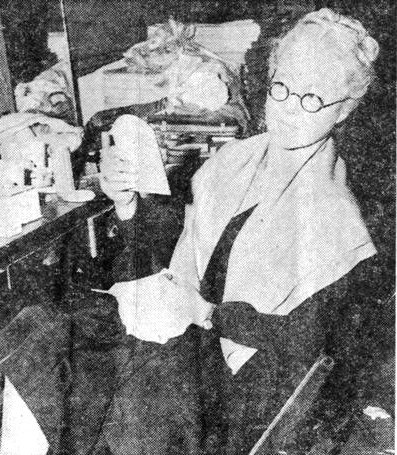 Here's Elinor fully made up. Anyone with enough curiosity to get an idea of how they will look in the distant
future cab get the makeup instructions from Miss Grant.
Here's Elinor fully made up. Anyone with enough curiosity to get an idea of how they will look in the distant
future cab get the makeup instructions from Miss Grant.
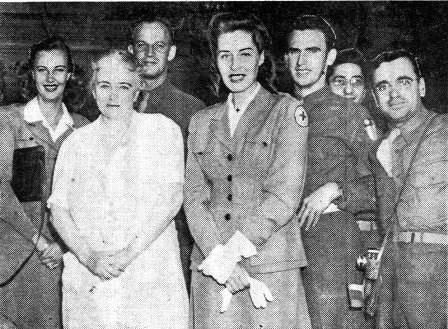 Lady Wavell, Vicereine of India, recently entertained members of U.S. forces at the Viceroy's House in New Delhi.
Shown above on the terrace are Kay Jackson, ARC; Lady Wavell, Cpl. Ray Wernimont, Eleanora Anderson, ARC; S/Sgt.
Charles Knichman, M/Sgt. George E. William and S/Sgt. Paul M. Pereira.
Lady Wavell, Vicereine of India, recently entertained members of U.S. forces at the Viceroy's House in New Delhi.
Shown above on the terrace are Kay Jackson, ARC; Lady Wavell, Cpl. Ray Wernimont, Eleanora Anderson, ARC; S/Sgt.
Charles Knichman, M/Sgt. George E. William and S/Sgt. Paul M. Pereira.
 HEIGHT IS MIGHT . .
Typical of the action which will mark the I.B.T. basket tourney which starts Dec. 10 in Calcutta, is this scene
from the Calcutta area finals. Craddock (left) of the Panagarh Ramblers and Charlie Snow of the Tollygunge Staters
lunge for the pelota. Panagarh won, 36-33.
HEIGHT IS MIGHT . .
Typical of the action which will mark the I.B.T. basket tourney which starts Dec. 10 in Calcutta, is this scene
from the Calcutta area finals. Craddock (left) of the Panagarh Ramblers and Charlie Snow of the Tollygunge Staters
lunge for the pelota. Panagarh won, 36-33.
